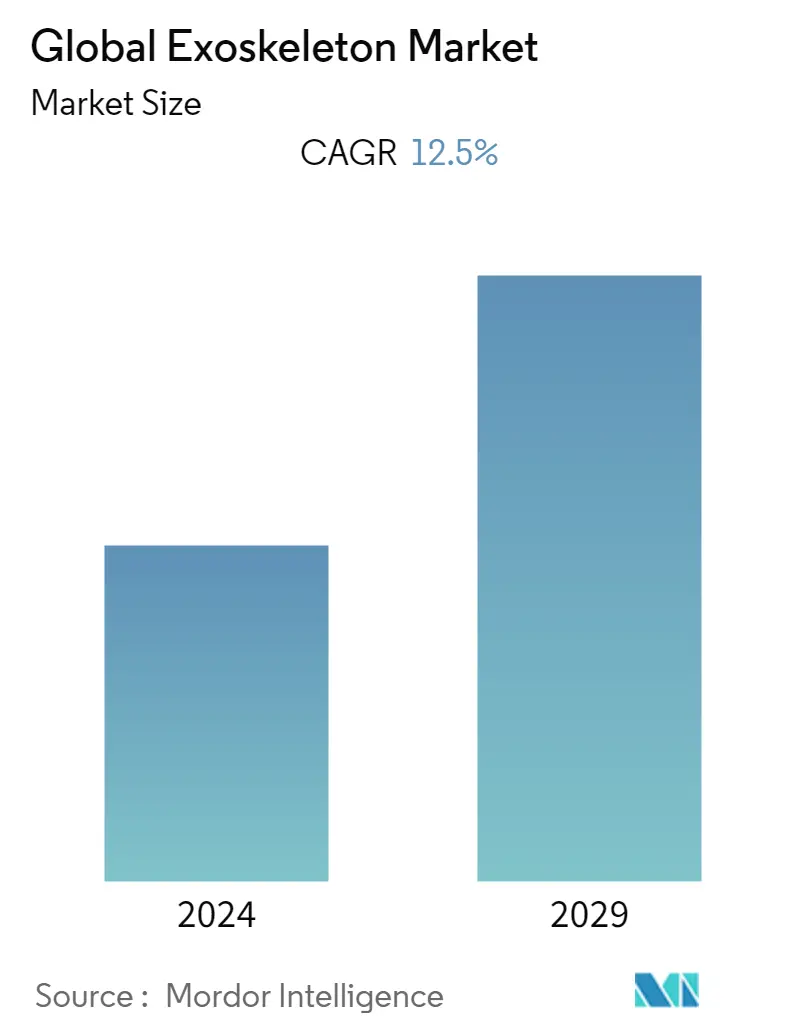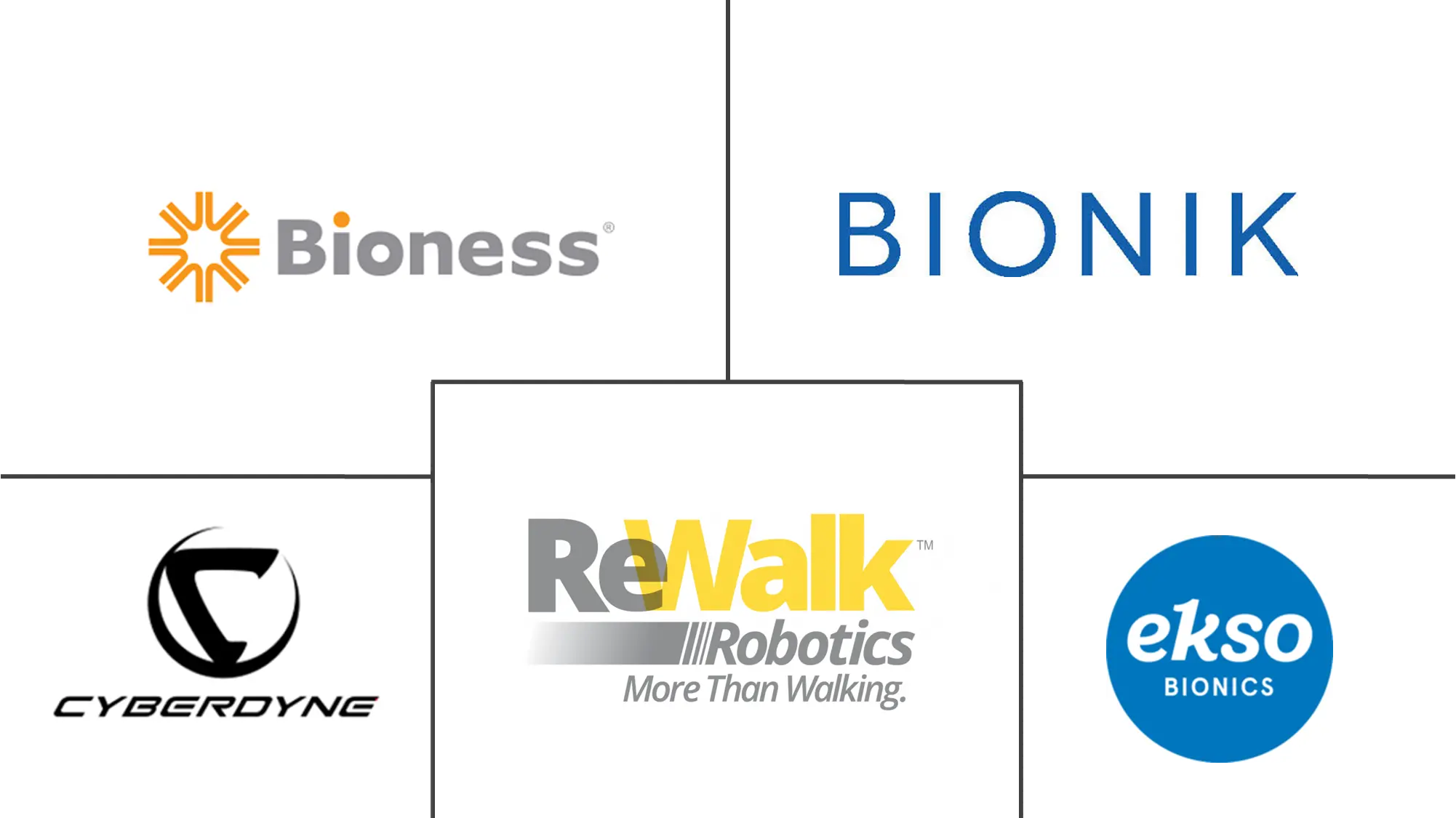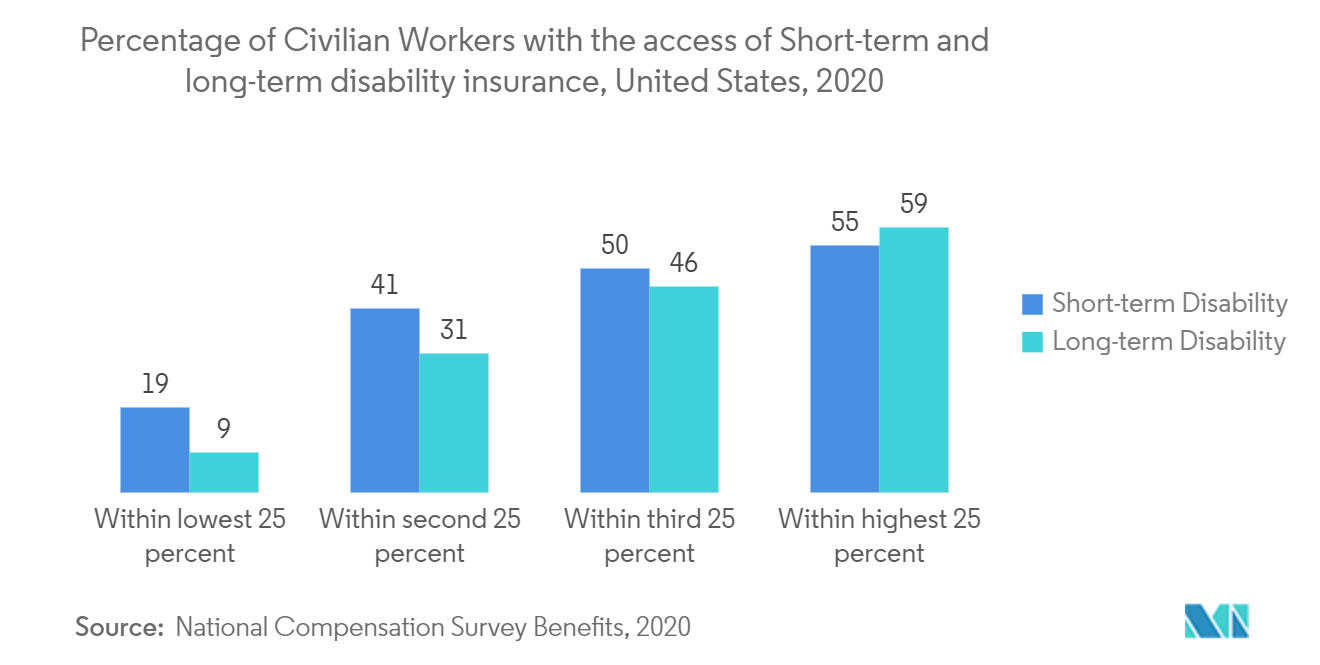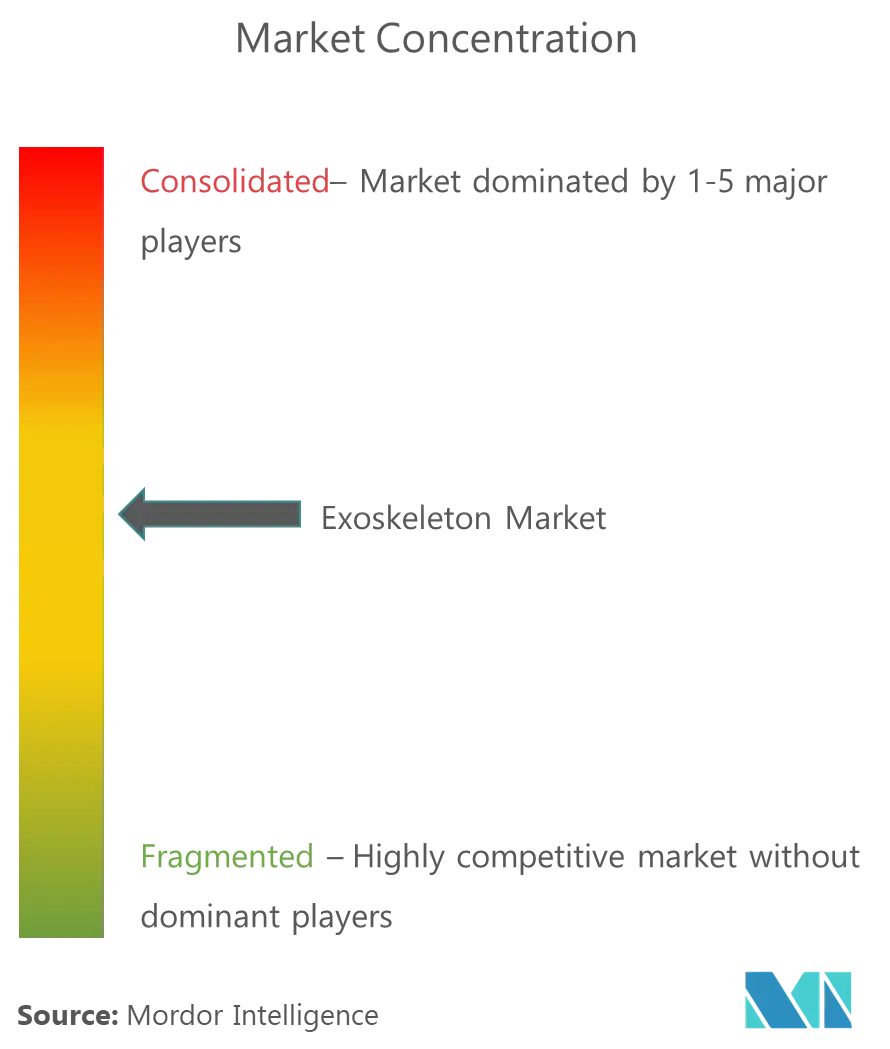Exoskeleton Market Size

| Study Period | 2019 - 2029 |
| Base Year For Estimation | 2023 |
| CAGR | 12.50 % |
| Fastest Growing Market | Asia Pacific |
| Largest Market | North America |
| Market Concentration | Medium |
Major Players
*Disclaimer: Major Players sorted in no particular order |
Exoskeleton Market Analysis
The exoskeleton market was valued at USD 354.22 million in 2021, and it is expected to reach USD 1620.04 million in 2027, registering a CAGR of 12.5% during the forecast period (2022-2027).
The COVID-19 pandemic is an unprecedented health concern, causing a huge setback. The pandemic significantly impacted the exoskeleton market worldwide. The use of exoskeletons is increasing in the management of COVID-19 patients with prolonged disability and problems in movement. For instance, as per a research article published in 2020, titled 'The use of exoskeletons to help with prone positioning in the intensive care unit during COVID-19', the preliminary results confirmed that the use of an exoskeleton for lumbar support is fully justified. The study states that using an exoskeleton to assist medical staff could be helpful and readily feasible, even in the context of the COVID-19 pandemic. As per a research article published in 2021, titled 'Biomechanical effects of using a passive back support exoskeleton during prone-positioning maneuver: A pilot study', during the COVID-19 pandemic, intensive care unit (ICU) staff had to perform prone-positioning (PP) of a large number of intubated patients suffering from acute respiratory distress syndrome (ARDS) many times a day. The study revealed that using the Laevo could help reduce the musculoskeletal load on the lower back during prone positioning maneuvers without causing any significant negative side effects or modifying the practice. The study states that two Laevos were successfully deployed in intensive care units of Centre Hospitalier Régional Universitaire de Nancy (CHRU Nancy), and they were used for six months. Thus, the demand for exoskeletons was significant during the pandemic. With the removal of lockdowns and the development of vaccines, the demand for exoskeletons as a part of rehabilitation is expected to increase. However, as per Ekso Bionics' 2020 annual report, the demand for exoskeleton products dramatically decreased by 38.0% during the onset of the pandemic, leading to the booking of 61 units in 2020 compared to 98 units in 2019.
The major factors propelling the market's growth are the rising prevalence of stroke, increasing adoption of the exoskeleton, and the growing geriatric population at a global level. With the increasing number of disabled and aged people, there has been an increase in the demand for robotic rehabilitation worldwide. In recent years, the demand for physical therapy services has grown, partly because of the aging population. The role of technology in healthcare has become evident with the enhanced rate of survival from medical disorders, such as stroke. Therefore, robotic rehabilitation and assistive technologies promise to ease the stress on the physiotherapy staff and control expenses while refining patients' quality of life.
There has been a growing demand for these robotic rehabilitation devices that are showing an upward trajectory as the prevalence of disability worldwide is increasing. For example, the United Nations estimates that the global geriatric population will reach 2.1 billion by 2050. The rates of disability are increasing due to the aging population and an increase in chronic health conditions. Therefore, the applications of robotic rehabilitation are growing fast with the market for these systems. One example is a robot developed at McGill University that helps patients who use wheelchairs to walk. It supports gait training and neuro-rehabilitation. Other researchers and companies are also developing products using robotics and 3D printing to help patients with movement disorders from an impaired spinal cord or due to stroke, Parkinson's disease, and multiple sclerosis. Numerous hospitals started using robotics within their rehabilitation centers. Product launches and innovations through key market players are another reason for the market's growth. For instance, in February 2020, Ekso Bionics announced a collaboration with Kindred Healthcare to pilot EksoNR in long-term acute care hospitals. Similarly, in January 2020, Bionik laboratories announced the regulatory approval and the first sale of its InMotion arm robotic technology by its exclusive distributor in South Korea. Hence, all these factors are expected to drive the overall market.
Exoskeleton Market Trends
This section covers the major market trends shaping the Exoskeleton Market according to our research experts:
The Mobile Segment is Expected to Hold the Largest Share by Product Type Over the Forecast Period
The user wears rehabilitation medical exoskeletons temporarily to improve performance. Therefore, the user no longer uses this exoskeleton following a supervised training regimen. A rehabilitation exoskeleton must be adjustable and must execute the exact motion many times and log the information for each patient. It is used by a patient in 1- to 2-hour sessions, mainly those with lower limb movement disorders. After using the rehabilitation devices, the patient starts to walk properly. The major factors fueling the segment's growth are the increasing prevalence of disability and the implementation of strategic initiatives by the market players.
As per an article titled 'A Review on Lower Limb Rehabilitation Exoskeleton Robots', published in 2019, China had the highest stroke rate globally. There were nearly 15 million disabled people with lower limb motor dysfunctions, such as cerebral palsy, hemiplegia, and paraplegia, and nearly 40 million disabled older adults had lost the ability to walk due to aging. Therefore, lower limb rehabilitation robots are of great significance in China. The use of rehabilitation robots can reduce the burden on therapists, realize data detection during training, and aid the quantitative evaluation of recovery in a controllable and repeatable manner. Several market players are contributing to the market's growth. For instance, in March 2021, Astrek Innovations, a healthcare start-up working with rehabilitation and assistive robotics, announced that it is in the last stages of product development and planned to begin user trials in the second quarter of 2021. The product development is accelerated by the Gurugram-based accelerator, Huddle. Astrek's Unik Exosuit range is a motorized wearable robot that can help people with lower limb disabilities in gait training and performing exercises.
Hence, the factors mentioned above are expected to drive the market's growth during the forecast period.

North America is Expected to Hold a Significant Market Share Over the Forecast Period
The key factors responsible for the large share of the North American market include the high purchasing power of patients, the growing geriatric population, and the public and private organizations offering grants and funds for the development of technologically advanced products.
According to the SCI Data Sheet from the National SCI Statistical Center (NSCISC), 2020, around 17,810 new spinal cord injuries are recorded each year in the United States, among which males account for about 78% of new spinal cord injury (SCI) cases. Approximately 294,000 people with SCI live in the United States. The current average age at the time of injury is 43 years old. Lengths of stay in the hospital acute care unit declined to 11 days (about one and a half weeks), and lengths of stay in rehabilitation declined to 31 days (about one month). Similarly, according to a September 2020 update by the Centers for Disease Control and Prevention (CDC), 26% of adults in the United States had some type of disability. Thus, due to these statistics, several market players are engaged in the implementation of strategic initiatives.
The increasing R&D is driving the market's growth. For instance, as per an August 2020 update by the National Institute of Standards and Technology (NIST), to help manufacturers and consumers mitigate the risks associated with exoskeletons, researchers at the National Institute of Standards and Technology developed a new measurement method to test whether an exoskeleton and the person wearing it are moving smoothly. Product launches are another reason for the market's growth. For instance, in March 2021, Ekso Bionics partnered with the US Physiatry to educate physicians on the clinical benefits of an EksoNR exoskeleton. The partnership will help raise awareness of the Ekso Bionics technology among physicians and other rehabilitation therapists. It will also teach them how to successfully integrate robotics into rehabilitation programs.
Thus, such factors are expected to boost the market's growth significantly over the forecast period.

Exoskeleton Industry Overview
The market is moderately consolidated. Some of the key players in the market are Cyberdyne, Ekso Bionics Holdings, Rewalk Robotics, and Bionik Laboratories. Therefore, the increasing investments by these players in the development of new and innovative products and the FDA approvals of their products are supporting the market's growth. For example, in January 2020, Bioservo Technologies announced the launch of its Ironhand 1.6 version for an optimized user experience for its patients.
Exoskeleton Market Leaders
-
Ekso Bionics Holdings
-
Rewalk Robotics
-
Cyberdyne
-
Bionik Laboratories
-
Bioness Inc.
*Disclaimer: Major Players sorted in no particular order

Exoskeleton Market News
In February 2022, CYBERDYNE Inc. announced that its application for a medical device marketing license for Medical HAL Single Joint Type, a wearable cyborg that improves physical functions, was approved by the Ministry of Health Republic of Indonesia.
In January 2022, CYBERDYNE Inc. announced a business alliance with MIHARU inc., which provides life partner services for seniors.
Exoskeleton Market Report - Table of Contents
1. INTRODUCTION
- 1.1 Study Assumptions and Market Definition
- 1.2 Scope of the Study
2. RESEARCH METHODOLOGY
3. EXECUTIVE SUMMARY
4. MARKET DYNAMICS
- 4.1 Market Overview
-
4.2 Market Drivers
- 4.2.1 Growing Demand from Healthcare Sector for Robotic Rehabilitation
- 4.2.2 Advancement in Robotic Technologies
- 4.2.3 Huge Investment for the Development of the Exoskeleton Technology
-
4.3 Market Restraints
- 4.3.1 Risks Involved with Using Exoskeletons Due to Vague Safety Guidelines
-
4.4 Porter's Five Forces Analysis
- 4.4.1 Threat of New Entrants
- 4.4.2 Bargaining Power of Buyers/Consumers
- 4.4.3 Bargaining Power of Suppliers
- 4.4.4 Threat of Substitute Products
- 4.4.5 Intensity of Competitive Rivalry
5. MARKET SEGMENTATION
-
5.1 By Treatment Type
- 5.1.1 Rehabilitation
- 5.1.2 Augmentation
-
5.2 By Body Part Type
- 5.2.1 Upper Body
- 5.2.2 Lower Body
-
5.3 By Product Type
- 5.3.1 Stationary
- 5.3.2 Mobile
-
5.4 By Geography
- 5.4.1 North America
- 5.4.1.1 United States
- 5.4.1.2 Canada
- 5.4.1.3 Mexico
- 5.4.2 Europe
- 5.4.2.1 Germany
- 5.4.2.2 United Kingdom
- 5.4.2.3 France
- 5.4.2.4 Italy
- 5.4.2.5 Spain
- 5.4.2.6 Rest of Europe
- 5.4.3 Asia-Pacific
- 5.4.3.1 China
- 5.4.3.2 Japan
- 5.4.3.3 India
- 5.4.3.4 Australia
- 5.4.3.5 South Korea
- 5.4.3.6 Rest of Asia-Pacific
- 5.4.4 Middle-East and Africa
- 5.4.4.1 GCC
- 5.4.4.2 South Africa
- 5.4.4.3 Rest of Middle-East and Africa
- 5.4.5 South America
- 5.4.5.1 Brazil
- 5.4.5.2 Argentina
- 5.4.5.3 Rest of South America
6. COMPETITIVE LANDSCAPE
-
6.1 Company Profiles
- 6.1.1 Cyberdyne Inc.
- 6.1.2 Ekso Bionics Holdings
- 6.1.3 Rewalk Robotics
- 6.1.4 Bionik Laboratories Corp.
- 6.1.5 Parker-Hannifin Corp.
- 6.1.6 Bioservo Technologies AB
- 6.1.7 Gogoa Mobility Robots
- 6.1.8 Rehab-Robotics Company Limited
- 6.1.9 Bioness Inc.
- 6.1.10 B-Temia Inc.
- *List Not Exhaustive
7. MARKET OPPORTUNITIES AND FUTURE TRENDS
** Subject To AvailablityExoskeleton Industry Segmentation
As per the scope of the report, exoskeletons are the external skeleton that supports and protects the body in contrast to the internal skeleton (endoskeleton). These are also wearable machines that enable limb movement with amplified strength and enhance the performance of human tasks. The exoskeleton helps people by providing support in walking, standing, carrying heavy objects, and contributing to healthcare. Using the exoskeleton technology helps reduce the effects of some of the disabilities like paralysis, general fatigue, and muscular dystrophy.
The exoskeleton market is segmented by treatment type (rehabilitation and augmentation), body part type (upper body and lower body), product type (stationary and mobile), and geography (North America, Europe, Asia-Pacific, Middle-East and Africa, and South America). The market report also covers the estimated market sizes and trends for 17 countries across major regions globally. The report offers the value in USD million for the above segments.
| By Treatment Type | Rehabilitation | |
| Augmentation | ||
| By Body Part Type | Upper Body | |
| Lower Body | ||
| By Product Type | Stationary | |
| Mobile | ||
| By Geography | North America | United States |
| Canada | ||
| Mexico | ||
| By Geography | Europe | Germany |
| United Kingdom | ||
| France | ||
| Italy | ||
| Spain | ||
| Rest of Europe | ||
| By Geography | Asia-Pacific | China |
| Japan | ||
| India | ||
| Australia | ||
| South Korea | ||
| Rest of Asia-Pacific | ||
| By Geography | Middle-East and Africa | GCC |
| South Africa | ||
| Rest of Middle-East and Africa | ||
| By Geography | South America | Brazil |
| Argentina | ||
| Rest of South America |
Exoskeleton Market Research FAQs
What is the current Global Exoskeleton Market size?
The Global Exoskeleton Market is projected to register a CAGR of 12.5% during the forecast period (2024-2029)
Who are the key players in Global Exoskeleton Market?
Ekso Bionics Holdings, Rewalk Robotics, Cyberdyne, Bionik Laboratories and Bioness Inc. are the major companies operating in the Global Exoskeleton Market.
Which is the fastest growing region in Global Exoskeleton Market?
Asia Pacific is estimated to grow at the highest CAGR over the forecast period (2024-2029).
Which region has the biggest share in Global Exoskeleton Market?
In 2024, the North America accounts for the largest market share in Global Exoskeleton Market.
What years does this Global Exoskeleton Market cover?
The report covers the Global Exoskeleton Market historical market size for years: 2019, 2020, 2021, 2022 and 2023. The report also forecasts the Global Exoskeleton Market size for years: 2024, 2025, 2026, 2027, 2028 and 2029.
Medical Exoskeleton Industry Report
Statistics for the 2024 Medical Exoskeleton market share, size and revenue growth rate, created by Mordor Intelligence™ Industry Reports. Medical Exoskeleton analysis includes a market forecast outlook to 2029 and historical overview. Get a sample of this industry analysis as a free report PDF download.



